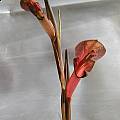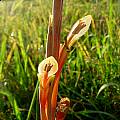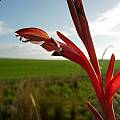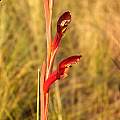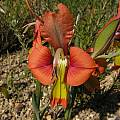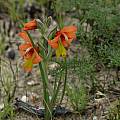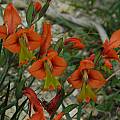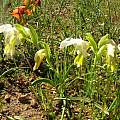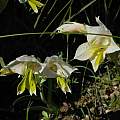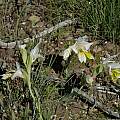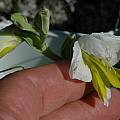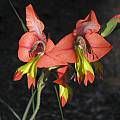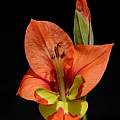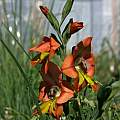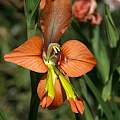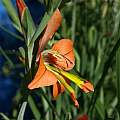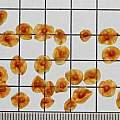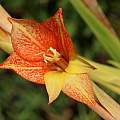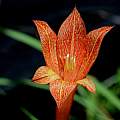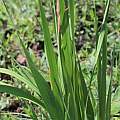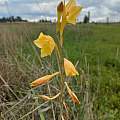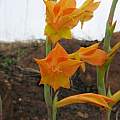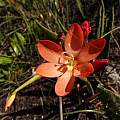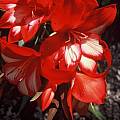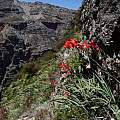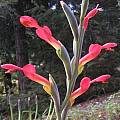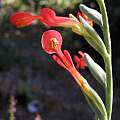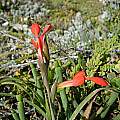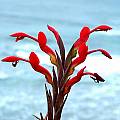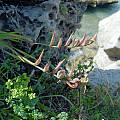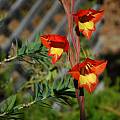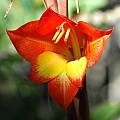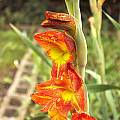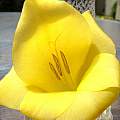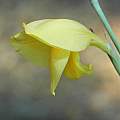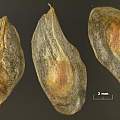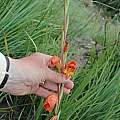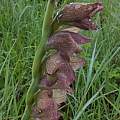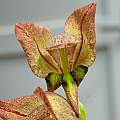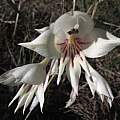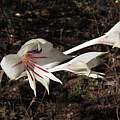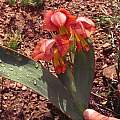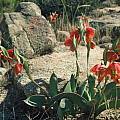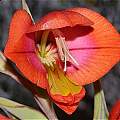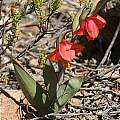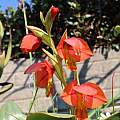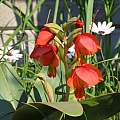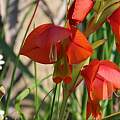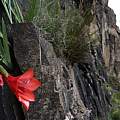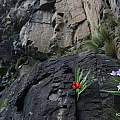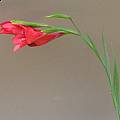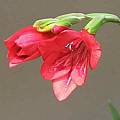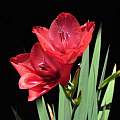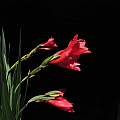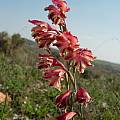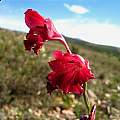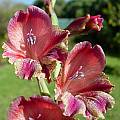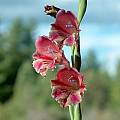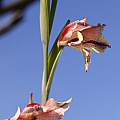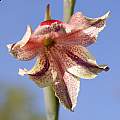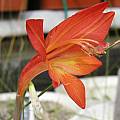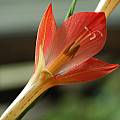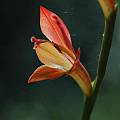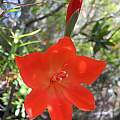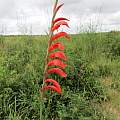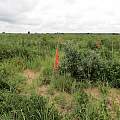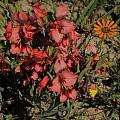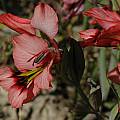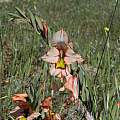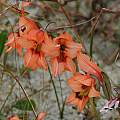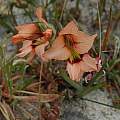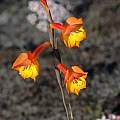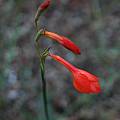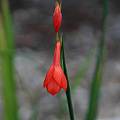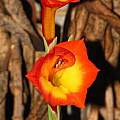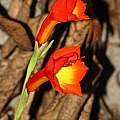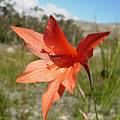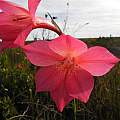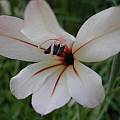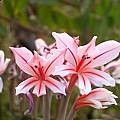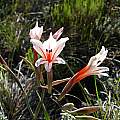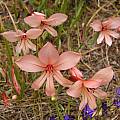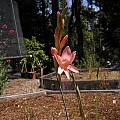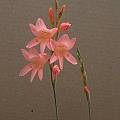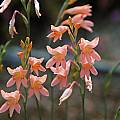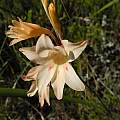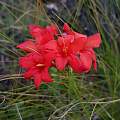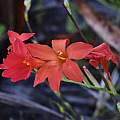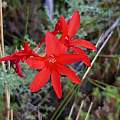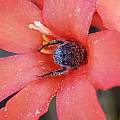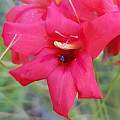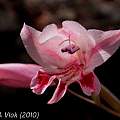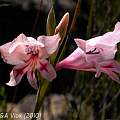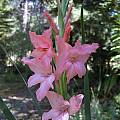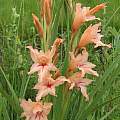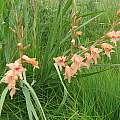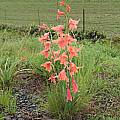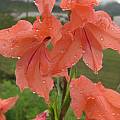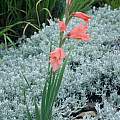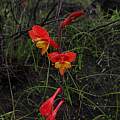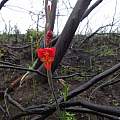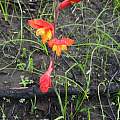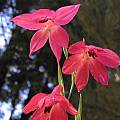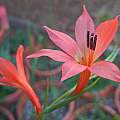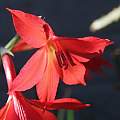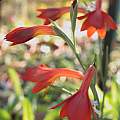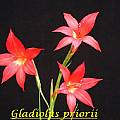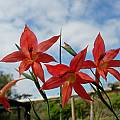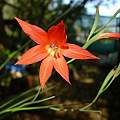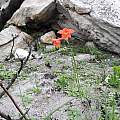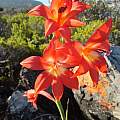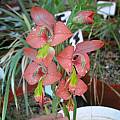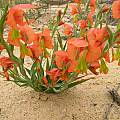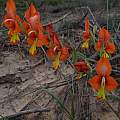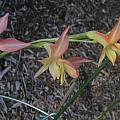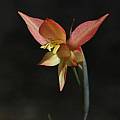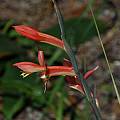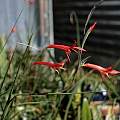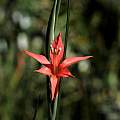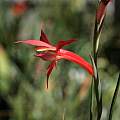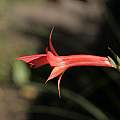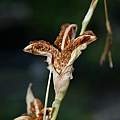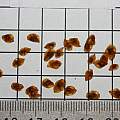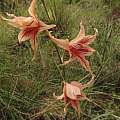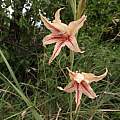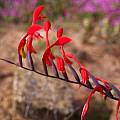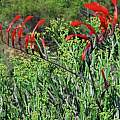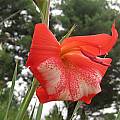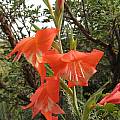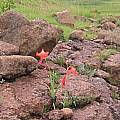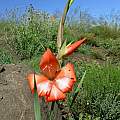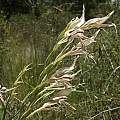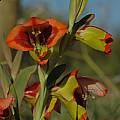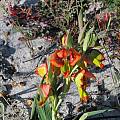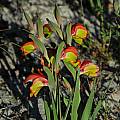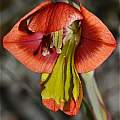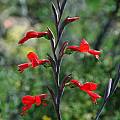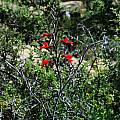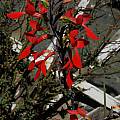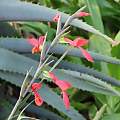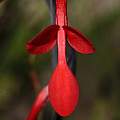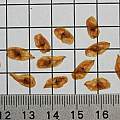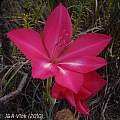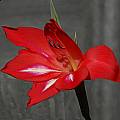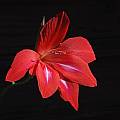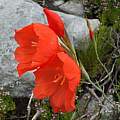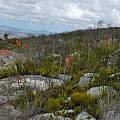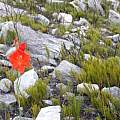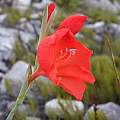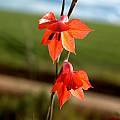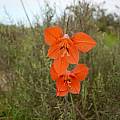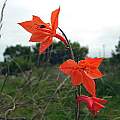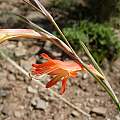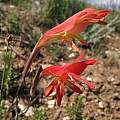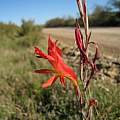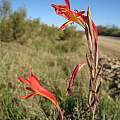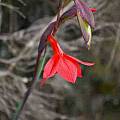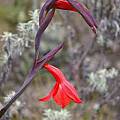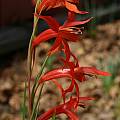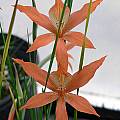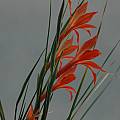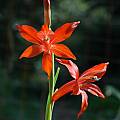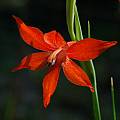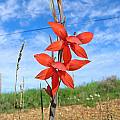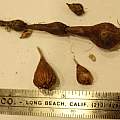Several species settle for these clear signal colors, often associated with bird pollination. This may result in very special flower shapes with long perianth tubes.
Though magenta is considered the basic red in printing color systems, we follow the common western color perception. Magenta colored Gladiolus can be found in the Purple Gladiolus index.
Gladiolus abbreviatus Andrews (syn. Homoglossum abbreviatum) is an odd species with grossly unequal dark red to brown tepals. Height is 30-65 cm. It is pollinated by sunbirds and occurs in the southwestern Cape where it is found in clay and shale banks in renosterveld. Although in the book above it is described as usually having 4 to 6 flowers my plants grown from seed only have a couple and ones seen in the wild also did not have very many flowers. The first photo was taken by Mary Sue Ittner of seed grown plants and the last three in habitat by Cameron McMaster near Napier in the Overberg.
Gladiolus alatus L. is a winter rainfall species found on flats, slopes, and plateaus, mainly in sand. The flowers are orange, marked yellow and have a light and pleasant scent. Height is 8-25 cm high. Photo 1 was taken near Paarl September 2003 by Bob Rutemoeller. The next two pictures were taken by Bob Rutemoeller and Mary Sue Ittner near Bainskloof September 2006.
Photos below are a white form of this species. The first photo was taken by Alan Horstmann. The next two photos from Mary Sue Ittner and Bob Rutemoeller were taken near Villiersdorp. The last photo by Bob Rutemoeller shows a white form for sale in a nursery in Caledon.
The photos below are of plants in cultivation. Photo 1 by Mary Sue Ittner shows flowers on a plant grown from seed blooming March 2005. Photo 3 from Bob Werra. Photos 3-6 were taken by Nhu Nguyen. Photo 5 show seeds on a 1 cm square grid.
Gladiolus antholyzoides Baker, Early Afrikaner, is distributed across the central and eastern high veld of South Africa. Flowers are yellow, sometimes streaked with red or orange and with an orange ring around the throat. Height range: 60-90 cm. This species is similar to Gladiolus dalenii, but that species has a dorsal tepal that is strongly arched and conceals the anthers. This species was once included in Antholyza as Antholyza schlechteri Baker, presumably because of its long perianth tube. It has also had other Gladiolus species names. Photos from iNaturalist were taken by tjeerd near Pretoria in November and otomys in December in Mpumalanga and shared under a CC BY-NC license.
Gladiolus aurantiacus Klatt is found in the summer rainfall area often growing in high grassland and is centered in KwaZulu-Natal extending into Mpumalanga and Swaziland. Growing from 45 to 75 cm high, it has stem leaves with short blades and foliage leaves with longer blades that are produced on separate shoots near the end of flowering. The unscented flowers are yellow, dotted or streaked with red or orange which gives them the appearance of being orange borne on a 10 to 16 flowered erect spike. Flowers have an elongate flower tube, slender in the lower half. The dorsal tepal is slightly ascending to horizontal and the lower tepals with yellow blotches in the lower half curve sharply downward. Flowers are adapted for pollination by sunbirds. Flowering is unusual as it occurs early, mostly in September and October, before the main rainy season has started. Photo from Rachel Saunders.
Gladiolus brevitubus G.J.Lewis grows on rocky sandstone slopes in the Southwestern Cape and flowers in spring. Plants grow from 12 to 35 cm high. Flowers are unusual, resembling a Tritonia, orange with yellow markings at the base of the lower tepals. Leaves are linear with lightly thickened margins and midribs. The photo was taken December 2013 by Rachel Saunders on steep slopes in the mountains near Hermanus.
Gladiolus cardinalis Curtis grows on wet cliffs and waterfalls in the southwestern Cape area of South Africa where the corms are wedged into cracks in the rocks where they are protected. Corms and roots must be constantly wet. This species flowers in the driest time of the year in midsummer (mid December to mid January), and is pollinated by the mountain pride butterfly. It is often found growing together with Disa uniflora, an orchid pollinated by the same butterfly. Growing from 55 to 90 cm tall, it has bright red flowers with white spear-shaped marks. This very beautiful species was one of the parents of modern day hybrids. The first photo was taken by Rod Saunders. The second photo from Rachel Saunders was taken January 2013 where it grows in a waterfall that plunges down the side of the mountain off a cliff that is probably 500 m high.
Gladiolus cunonius (Linnaeus) Gaertner (syns. Anomalesia cunonia, Antholyza cunonia) has bright red flowers and blooms in the spring and grows in sandy soils near the coast. Plants grow from 20-70 cm high. The first three photos were taken by Bob Rutemoeller and Mary Sue Ittner and the next three by Cameron McMaster in habitat near Agulhas and Arniston in the Overberg. The last picture shows the seed capsules hanging over the cliff near the ocean.
Gladiolus dalenii Van Geel is a widespread and common species found not only in Southern Africa, but also in other parts of tropical Africa. It has been known by a number of names over the years; there have been 27 synonyms for the tropical Africa and Madagascar forms and 14 more for the southern African forms. The main synonyms for the southern Africa collections have been Gladiolus natalensis and Gladiolus psittacinus. This species blooms at different times of the year depending on the location, but there are probably flowers every month of the year somewhere in its native habitats. Flowers are either red to orange with yellow markings on the lower half of the three lower tepals or yellow to greenish with red to brown streaks on the upper tepals. Plants can grow 1-2 m high. Although it favors moist habitats and is often found in grassland, it can also be found in dry habitats with only a short wet season. The ones I grew in Northern California lived for a number of years in the garden, dormant during our wet winters, appearing late spring and surviving through the dry summer and blooming in the fall. The flowering stalks were very tall with a number of flowers. Photos 1-2 of those plants were taken by Mary Sue Ittner. Photo 3 by Cameron McMaster shows plants in cultivation. Photos 4-5 by Mary Hunter and Mary Sue Ittner show the first bloom from seed of a yellow form of ssp. dalenii, once known as Gladiolus primulinus blooming in late summer in Northern California. The last photo by David Pilling shows seed.
The first photo below from Cameron McMaster shows flowering plants in habitat in the Eastern Cape. The second is another habitat shot taken near Balloch in the Eastern Cape, January 2010 by Bob Rutemoeller. Photo Nr. 3 from Rachel Saunders shows an unusual color form and was taken in northern KwaZulu-Natal in January 2015. The last photo shows the beautiful detail on likely the same color form, as the seeds were obtained from Silverhill, flowering the second year from seed for Martin Bohnet.
Gladiolus engysiphon G.J.Lewis is found in clay and granitic loam in renosterveld and grassland in the Langeberg Center (Swellendam to Mossel Bay). Growing from 35 to 50 cm high, it flowers March to April. The cream flowers with red median streaks are arranged in a 2 to 6 flowered spike. Photos taken by Rogan Roth in the southern Cape in April 2021. He first thought it was Gladiolus bilineatus which has a similar flower, distribution, and flowering time in the autumn. Both are pollinated by a species of long-proboscid fly. According to John Manning the lowest leaf in Gladiolus bilineatus always develops a short, sword-shaped blade, whereas the leaf blades in Gladiolus engysiphon are either absent entirely or needle-like. The arrangement of the leaves and the diameter of the stem is also different in the two species.
Gladiolus equitans Thunberg is very similar to Gladiolus alatus but has short, broad leathery leaves with raised margins and grows on rocky hills in Namaqualand. The first one was photographed in Namaqualand in August 2001 just after it rained by Mary Sue Ittner. The second photo was taken in about the same place in September 2006 by Bob Rutemoeller, but the plants were already in seed this time. The third picture was taken by Rod Saunders. The fourth and fifth photos were taken in habitat in the Kamiesberg by Andrew Harvie.
Photos below were taken by Alan Horstmann.
Gladiolus flanaganii Baker grows on the cliffs of the Drakensberg mountains in KwaZulu-Natal which form the border between Lesotho and South Africa. Height range: 35-60 cm. Long ago, plant collectors would risk death to see/collect these plants, thus it has gained the vernacular name "Suicide Lily". In milder climates maritime, it does well in a very well drained mix, full sun, and occasional watering. Water should be given often during hot spells. Keep the bulbs dry during their winter dormancy.
The photos below were taken by Callan Cohen of plants in habitat.
Photographs 1-2 taken by David Victor are of a wild collected material recently given to him by Danish friends. Photo 3-5 were taken by Nhu Nguyen who grew this in his Berkeley garden in a 1 gallon pot.
Gladiolus guthriei F.Bolus is a winter-growing species that occurs on rocky sandstone outcrops in the Western Cape. It incorporates plants formerly known as Gladiolus odoratus L.Bolus. It blooms in fall to early winter; April to June in its native range. Plants that will bloom send up a flowering stalk with very short leaf stubs on it. Plants not blooming in that year produce a long leathery leaf. The flowers generally have a pale yellow or straw base color, liberally decorated with mauve or dark magenta streaks and freckles. The result looks fairly dull from a distance, but the flowers reward close examination. They have a sweet scent. Height range: 40-70 cm. First four photos taken in Napier and Villiersdorp in the Overberg by Cameron McMaster. The fourth and fifth photos are of the Gladiolus odoratus form, blooming in December in California by Michael Mace.
Gladiolus huttonii (N.E.Br.) Goldblatt & M.P.de Vos syn Homoglossum huttonii N.E.Br is found on sandstone slopes in the southeastern Cape and flowers winter to spring. It has red to orange flowers with the lower tepals sometimes yellow. Height range: 30-60 cm. The first photo was taken by Bob Rutemoeller of a plant grown by Alan Horstmann. The next two pictures were taken by Mary Sue Ittner. Photos of many interesting hybrids of this species are found on the Gladiolus hybrids wiki page.
Gladiolus insolens Goldblatt & J.C.Manning grows in a few wet sites along streams and seeps in rocky areas on the higher slopes of the Piketberg in the western Cape. It has a spike of one to three bright scarlet flowers and five to seven narrow grey green leaves. Height range: 30-50 cm. Photo by Rachel Saunders.
Gladiolus magnificus (Harms) Goldblatt is a southern tropical African species found from central Angola through southern Zambia to western Zimbabwe. It is also found in the northern edges of Namibia and Botswana. In the past this species has been included in Antholyza under three species names as well as being included in Chasmanthe and Oenostachys. It has bright red flowers with a long perianth tube and reduced lower tepals with yellow markings. Tepals are very unequal with the dorsal the largest, hooded and horizontal. The laterals are broadly lanceolate and directed forward. Height range: 80-140 cm. It flowers in January and February. Photo from iNaturalist taken by Cody Coyotee Howard in Namibia and shared under a CC BY-NC license.
Gladiolus meliusculus (G.J.Lewis) Goldblatt & J.C.Manning, syn. Gladiolus alatus var. meliusculus is found on low hills and flats on the western Cape coastal plain where it grows in sandy sites formed from decomposed granite or sandstone that are waterlogged during the period of growth. Flowers are salmon, brick-red or orange with yellow markings on the lower tepals. Gladiolus meliusculus differs from Gladiolus alatus by having shorter stamens and the yellow on the lower tepals is less pronounced and edged by a band of red-purple and the upper halves are pink to orange. Height: 12-25 cm. The first three photos were taken by Mary Sue Ittner and Bob Rutemoeller September 2006 near Darling. The other two were taken near Brackenfell on Rod and Rachel Saunders' property where they are growing this species.
Gladiolus merianellus (L.) Thunb. is a species that has had many different names and settled for a while under Gladiolus bonaespei Goldblatt & M.P.de Vos (originally spelled bonaspei). Other synonyms are Homoglossum merianellum (Thunb.) Baker, Homoglossum merianellum (Thunb.) Baker var. aureum G.J.Lewis, and Petamenes pilosus (Klatt) Goldblatt. It has also been known as Watsonia pilosa Klatt. This species grows on sandy flats and slopes in the Southwest Cape. It has 2 to 7 orange, rarely yellow flowers. Flowers held up very well during a wet period in February when they bloomed and over the course of the blooming period the color changed slightly from all orange to orange with yellow tones. Height range: 30-50 cm. The first photo is from Rod Saunders. The next three photos are from Mary Sue Ittner and the following two are by Dylan Hannon of the first flowering of his seed-grown plants 10 years after sowing.
Gladiolus meridionalis G.J.Lewis is found in the Southern Cape from the Overberg to Port Elizabeth (both winter and summer rainfall areas) and flowers from June to August. The distribution is discontinuous. Plants grow in stony sandstone soils in low fynbos on mountain slopes and flats that are usually in sight of the ocean. The populations in the west of the range have dark pink to salmon flowers and those in the east have cream to pinkish orange flowers. Flowers are adapted for pollination by sunbirds with a long perianth tube. An article here describes a rare finding of this species. Height: 35-45 cm. The first photograph from Cameron McMaster was taken on the farm Fairfield in the Napier district where it occurs on sandstone slopes. The second photo was taken by Rachel Saunders.
Gladiolus miniatus Eckl. is found on coastal limestone outcrops from Hermanus to Agulhas. Spring blooming flowers are salmon with red along the midline. Height: 15-40 cm. The first photo was taken by Dirk Wallace and the second and third by Cameron McMaster at Arniston. The last two photos were taken by Mary Sue Ittner in May 2005 when they were blooming for the first time from seed in Northern California with California bulb companions Brodiaea jolonensis, Allium unifolium and Triteleia hyacinthina in bloom in the same raised bed.
Gladiolus monticola Goldblatt & J.C.Manning is found on rocky sandstone slopes in the southwestern Cape. There are populations on Table Mountain. It has pink to apricot flowers with darker pink markings on the lower tepals and blooms summer into fall before the single leaf is produced. Height: 30-45 cm. The first two photos by Bob Rutemoeller. This first photo shows it as the only bulb blooming in one of our raised beds that only has bulbs from winter rainfall areas, blooming in July 2003 in the northern hemisphere. The leaf in the picture is of another Gladiolus that bloomed a month earlier. In the second photo we put cardboard behind the flowers to get the close-up that shows the details better. The third photo was taken years later by Mary Sue Ittner. The last photo from Rachel Saunders was taken on Table Mountain February 2011.
Gladiolus nerineoides (N.E.Br.) G.J.Lewis is found on rocky sandstone slopes and cliffs in the southwestern Cape, flowering January-March. Growing from 35 to 60 cm high and flowering before the leaves are produced, it has funnel shaped scarlet flowers crowded together. Photos from iNaturalist taken by Peter Thompson in February and shared under a CC BY-NC license.
Gladiolus nigromontanus Goldblatt is a rare South African species that occurs only on rocky outcrops on sandstone slopes in the Swartberg Mountains. Flowering in autumn (March) and best a few years after a fire, it grows to 30-40 cm high with narrow leaves and small white long tubed flowers suffused light pink and marked with red and yellow on the three lower lobes. Flowers are in a 3 to 6 flower spike. Photos from the book Plants of the Klein Karoo courtesy of Jan and Anne Lise Schutte-Vlok.
Gladiolus oppositiflorus Herb. is found in the southern part of the summer rainfall area where it grows in open grasslands and often in rocky sites where there is some protection from predators. Flowers are salmon to pale pink or mauve, with the lower three tepals paler in the midline and having a reddish to purple median streak. Height range: 60-160 cm. This species blooms summer into fall. The first two photos by Mary Sue Ittner of a plant growing in the ground in Northern California and blooming late August-September 2004. The last two photos were taken by Cameron McMaster at Maclear in the Eastern Cape February 2008.
A shorter-stemmed form with salmon colored flowers was described as Gladiolus salmoneus Baker and later considered to be Gladiolus oppositiflorus ssp. salmoneus (Baker) Oberm. Although this subspecies is still recognized by Kew, Goldblatt and Manning in Gladiolus of Southern Africa did not think the differences warranted subspecies treatment. The first two photos of this form taken in the Eastern Cape January 2008 by Cameron McMaster. The last photo is from Rachel Saunders.
Gladiolus overbergensis Goldblatt & M.P.de Vos is a rare species found in the southern part of the southwestern Cape. Growing from 35 to 50 cm high, it is reported to be found in sandy loam and fynbos or fynbos-renosterveld, flowering July-September. Flowers are bright red to orange with a long perianth tube which could make them adapted for pollination by sunbirds. Past names include Antholyza guthriei L.Bolus and Homoglossum guthriei (L.Bolus) L.Bolus. Photo from iNaturalist taken by Lindsay Lewis taken in the Overberg in June and shared under a CC BY-NC license.
Gladiolus priorii (N.E.Br.) Goldblatt & M.P.de Vos (syn. Homoglossum priorii (N.E.Br.) N.E.Br.) is a fall blooming species (April to June) found on sandstone and granite slopes in the Southwestern Cape, South Africa. Growing from 30 to 40 cm high, it has leathery linear leaves and tubular red flowers with yellow throats in a one to four flowered spike. They droop slightly, making it hard to see the centers unless you crouch down. It is considered relatively easy to grow in captivity, although Mary Sue Ittner has found in her Northern California coastal garden that it is short lived and has to be started regularly from seed. The first photo from Bob Rutemoeller shows a plant growing in the ground, flowering in November. The second photo was taken by Mary Sue Ittner, the third by Alan Horstmann, the fourth by Michael Mace, and the last by Bill Dijk.
The first two photos were taken by Cameron McMaster. The last two photos were taken by Rachel Saunders. The first of these was taken June 2011 of this species blooming on Table Mountain in the southwestern Cape in an area that had previously burned and the second in Hermanus.
Gladiolus pulcherrimus (G.J.Lewis) Goldblatt & J.C.Manning has very striking orange to salmon flowers that are similar to Gladiolus alatus but is distinguished by broad sword shaped leaves that lack prominent veins. It grows in the northwest Cape on sandstone slopes. Height range: 20-60 cm high. The first photo from Bob Rutemoeller is of a plant grown by Gordon Summerfield in South Africa, which was blooming September 2003. The next two photos by Alan Horstmann, and Rod Saunders.
Gladiolus quadrangularis (Burm.f.) Ker Gawl. (syn. Homoglossum quadrangulare) is found on rocky sandstone slopes in the Northwest Cape. It has 4 to 10 red to orange flowers and blooms late winter into spring. Height range: 50-90 cm tall. Photos 1-3 were taken by Mary Sue Ittner showing plants that bloomed in Northern California March 2004 and 2007.
The photos below were taken by Nhu Nguyen. The seeds are on a 1 cm grid.
Gladiolus reginae Goldblatt & J.C.Manning is a rare species known from only two populations where plants grow in open woodland in rocky outcrops, partially shaded by shrubs and trees, in heavy metal-enriched soils. Growing from .4 to 1.5 m, it has 7 to 16 unscented long tubed flowers in an erect spike. Flowers are pale flesh-pink flushed deeper salmon and the lower three tepals are flushed deep red in the basal third with longitudinal lines. The upper three tepals are flushed deep red at the base. Flowering takes place from mid March to mid April, but may skip a year if it's too dry. Goldblatt and Manning report that flowers are pollinated by long-proboscid flies, but also attract ants with sweet droplets from the tips of the bracts, likely for protection from other insects.
Photos by Rachel Saunders shows specimens found in the Blyde River Canyon Nature Reserve (situated in Mpumalanga).
Gladiolus saccatus (Klatt) Goldblatt & M.P.de Vos, formerly known as Anomalesia saccata or Antholyza saccata, extends from the western Cape of South Africa into Namibia. It is found in both summer and winter rainfall areas. It has bright red flowers and is pollinated by birds. This one was growing alongside the road in Namaqualand. Height range: 25-80 cm. Photo #1 taken August 2001 by Mary Sue Ittner. The second photo was taken by Rod Saunders.
Gladiolus saundersii Hook.f. is native to the southern and central Drakensberg and grows in summer on rocky outcrops, scree slopes and other exposed habitats in dry spots that are seasonally wet. It has bright red flowers that face sideways or are drooping. The lower three tepals are speckled in the lower half with red on a white field. Height: 40-60 cm. This species is pollinated by butterflies. It is a winter-dormant species and its habitat is very cold in winter with frequent snow. It was named after Katherine Saunders who was a botanical artist in Natal in the 1800s. Photos 1-3 taken in the Eastern Cape February 2008 and photo 4 taken at Naude's Nek January 2010 by Cameron McMaster.
Gladiolus sekukuniensis P.J.D.Winter is known from two sites in Sekukuniland, west of the Transvaal Drakensberg where it is found on alkaline soils in open woodland and flowers from March to April. It grows from .6 to 1 m and has linear leaves with a thickened and raised midrib and a spike of 8 to 17 flowers. Flowers are white or cream to pale salmon pink with a narrow, dark red, longitudinal median streak on each tepal except for the dorsal where the streak is sometimes incomplete or lacking. The lower tepals sometimes have a yellow streak in the center. Flowers are distinctively windowed (in profile there is gaping between the dorsal and upper lateral tepals) with the tepals unequal and narrowed below into claws with twisted and undulate tail-like tips. Photos by Rachel Saunders.
Gladiolus speciosus Thunb. is found in deep sandy soils in the Northwest and Southwest Cape. It is similar to Gladiolus alatus with 2 to 8 flowers in a spike, orange marked yellow to greenish and hooded over the stamens. One of the distinguishing characteristics is that it is colored yellow on the reverse. Height range: 12-20 cm. The first four photos taken in the western Cape near Darling September 2006 by Bob Rutemoeller and Mary Sue Ittner. The last photo was taken by Andrew Harvie near Bokbaai in the Western Cape.
Gladiolus splendens (Sweet) Herb., formerly known as Anomalesia splendens (Sweet) N.E.Br., is found in rocky clay, mostly near streams in the Roggeveld and the Calvinia district. The bright red flowers are formed in a strongly inclined spike. Height: 50-110 cm. Photos 1 and 2 were taken by Mary Sue Ittner near Middelpos September 2006; photo 3 was taken by Bob Rutemoeller in a garden in Calvinia. Photo 4 was taken by Alan Horstmann. Photo 5 was taken by Uluwehi Knecht. Photo 6 by Nhu Nguyen shows the seeds on a 1 cm square grid.
Gladiolus stefaniae Oberm. grows in the mountains of the southern Cape on rocky slopes in gullies that are wet. It grows up to 60 cm. This species flowers at the end of the dry hot summer after the weather has become cooler and it has started to rain. The flowering stem is produced before the leaf. The large flowers are red with a median white streak in the lower two-thirds of the lower three tepals and are pollinated by the mountain pride butterfly. The first photo from the book Plants of the Klein Karoo courtesy of Jan and Anne Lise Schutte-Vlok. The last two photos by Mary Sue Ittner are close-ups of the first flower (of two) blooming September-October 2008 in Northern California. It has continued to flower, but not increase. It usally flowers in California before our rainy season has started.
Gladiolus stokoei G.J.Lewis is found on marshy sandstone slopes from 500 to 1000 m in the Riviersonderend Mountains (Southwest Cape.) Flowering March to April, it grows from 30 to 45 cm with the scarlet tulip shaped flowers (in a one to three flowered spike) appearing before the solitary linear leaf. Photos taken March 2016 by Rachel Saunders.
Gladiolus teretifolius Goldblatt & M.P.de Vos (syn. Homoglossum muirii) is a rare plant found in the southern Cape growing in heavy soils in renosterveld. It has scarlet flowers and blooms fall to winter. Height range: 40-70 cm. Photos taken by Cameron McMaster in the Overberg, Bredasdorp and Agulhas.
Gladiolus vandermerwei (L.Bolus) Goldblatt & M.P.de Vos, syn. Antholyza vandermerwei L.Bolus, syn. Homoglossum vandermerwei (L.Bolus) L.Bolus , has a narrow distribution in the central part of the western Cape where it is found on shale slopes in renosterveld in dry habitats. It has bright red flowers with an elongated perianth tube. The lower tepals are short and narrow, yellowish in the lower half and arch outward. Height range: 30-60 cm. Photos were taken near Bredasdorp in the Overberg by Cameron McMaster in September in different years.
Gladiolus watsonioides Baker is found on the mountains of Kenya and northern Tanzania, growing from 2600 m to 3900 m. It is not quite a true alpine, but not far off. There is a frost almost every night and the plant copes with this well at all stages of its growth. With the almost constant daylength and general conditions through the year the plant can remain active without going dormant. This evergreen habit is maintained in cultivation & the plants remain green throughout the year if kept moist, but they can go dormant if they dry out. I have stocks from both mountains (Kilimanjaro and Mt. Kenya) and they grow equally well in a gritty, humus-rich compost in deep pots in a frost-free greenhouse, but there is no doubt that the Mt Kenya version is the one to grow. Height range: 1 to 2.3 ft. Description and photos by John Grimshaw. The last two images are of the Mt. Kenya version.
Gladiolus watsonius Thunb. has had multiple names over the years. It has been included in Watsonia, Homoglossum and Antholyza before settling in Gladiolus. It is found on clay and granite slopes in renosterveld in the northwest and southwest Cape. It blooms in late winter, early spring with an erect spike of red to orange flowers. Height range: 30-70 cm. The first photo below was taken by Bob Werra and the second by Susan Hayek in the greenhouse of Diana Chapman. Photos three to five by Mary Sue Ittner of plants at Telos and plants blooming in her garden in February 2007. The sixth photo was taken by Alan Horstmann.
The photo below shows some dormant corms. The tunics can sometimes have a papery outer layer, as shown by the larger corm on top. But the two smaller corms at center show the "teeth" at the bottom of the tunic that are typical for this species. Photo by Michael Mace.
